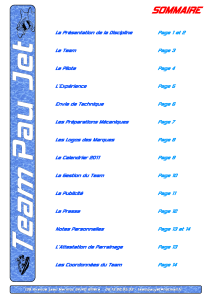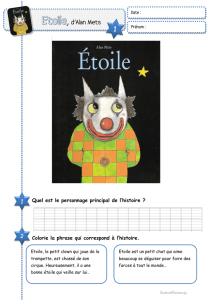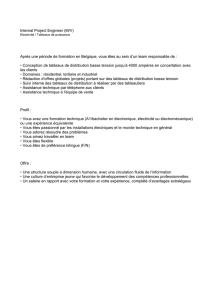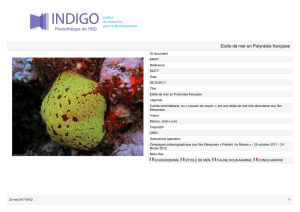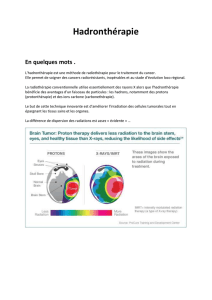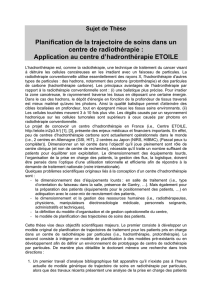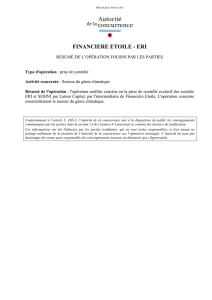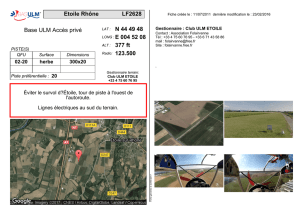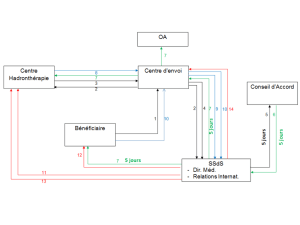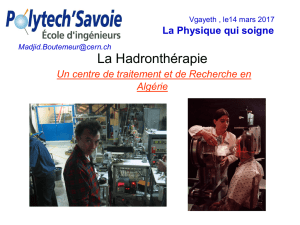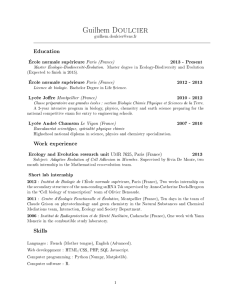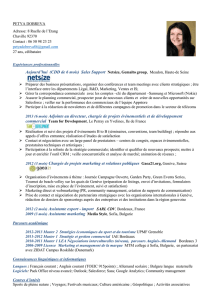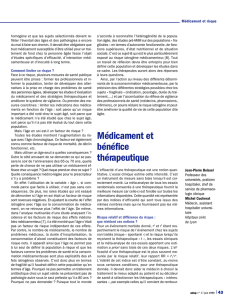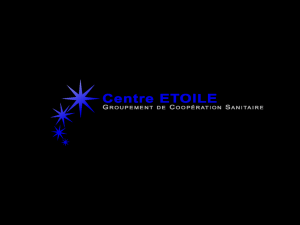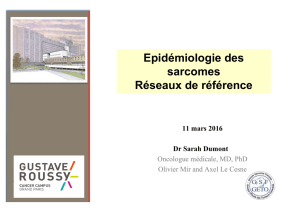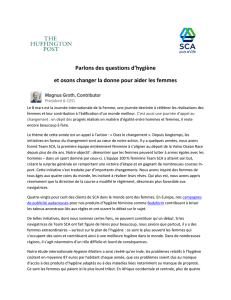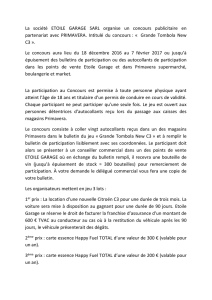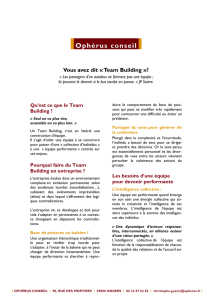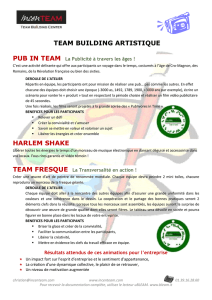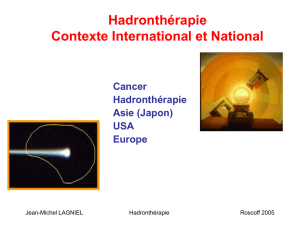Etude d`incidence des cancers éligibles pour une hadronthérapie
publicité
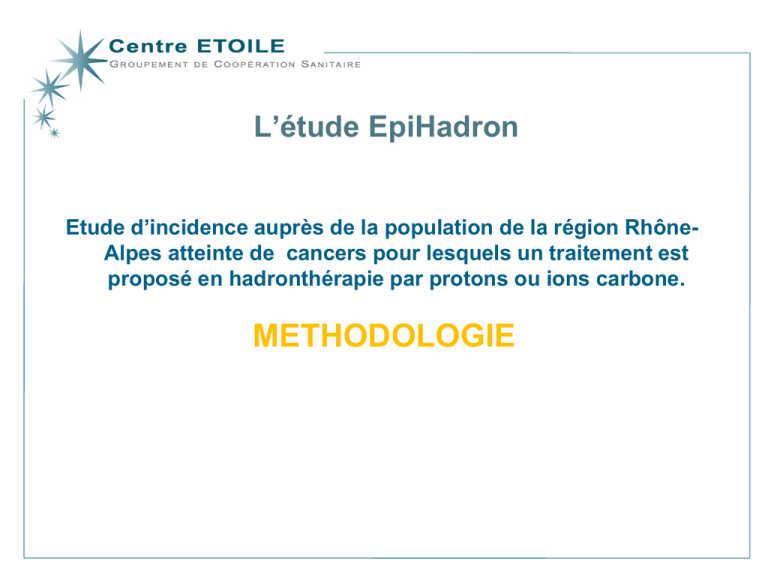
L’étude EpiHadron Etude d’incidence auprès de la population de la région RhôneAlpes atteinte de cancers pour lesquels un traitement est proposé en hadronthérapie par protons ou ions carbone. METHODOLOGIE Contexte - PNRH : Programme National de Recherche en Hadronthérapie - Le GCS ETOILE : groupement des CHU et CRLCC Rhône Alpes : ouvert en 2008 pour la construction et exploitation du centre nationale de carbone thérapie - Financement par L’Inca dès 2008 d’OMéRRIC: Organisation Médicale pour le Recrutement des patients pour une Radiothérapie par Ions Carbone - Réponse au Plan cancer et thématique cancéropole R. Alpes le CLARA La carbone thérapie en bref Précision balistique avec dépôt de la dose au cœur de la tumeur Une efficacité biologique anti-tumorale (1.5 à 3 fois supérieure) aux photons, électrons et aux protons Gains pour le patient ! Cliniques: conserve les tissus sains autour de la tumeur Conservateur : préserve l’intégrité physique du patient ( tumeur inopérables) Qualité de vie: réduction des effets secondaires et du risque de séquelles Adenoid Cystic carcinoma of maxillary sinus (Pr Tsujii, NIRS) Problématique - Peu de données épidémiologiques disponibles concernant l’hadronthérapie - Aucune information dans les registres de cancer - Une demande de soin en augmentation Nécessité de réaliser une évaluation de la demande de soin Objectifs • Objectif principal Evaluer en région Rhône-Alpes l’incidence des cancers éligibles et jugée prioritaire pour un traitement par hadronthérapie par protons ou ions carbone. • Objectifs secondaires 1) caractériser la population atteinte, 2) décrire les cancers dénombrés dans l’étude, 3) décrire les caractéristiques des thérapeutiques proposées Perspectives et enjeux 1 . Préfigurer le design des futures études cliniques. 2. Elargir les connaissances scientifiques concernant l’épidémiologie des patients atteints de cancers rares et pouvant être traités uniquement avec hadronthérapie Méthode/ matériel Etude descriptive, multicentrique, prospective, Experts des RCP « spécialisées » ou « organe » Enregistrement : questionnaire papier, par un ARC institutionnel Management: Coordination avec le 3C du territoire/ acteurs des réseaux de cancérologie Inca 8 Definition and validation of the items (2 or 3 French physicians + 1 European) Drafting of protocol Jean- Pierre Boissel team - 1 item = a specific indication + a given treatment 1. Revue bibliographique - « Evidence based medecine » Research of the studies Jean- Pierre Boissel team Strategy: -Design of the study -Studied pathology -Tested treatments 2. Réunion d’experts Sources: -Medline, Cochrane Library - Institutions ‘websites and recommendations - Others websites (on going studies) Bibliographic database managed with ReferenceManager 3. Synthèse des démarches Critères principaux de recherche service médical rendu ou attendu - survie - qualité de vie Selection of the studies 1st Jean-Pierre Boissel team Jean-Pierre Boissel team step : abstracts Jean-Pierre Boissel team Jean-Pierre Boissel team 2nd step: full text then publication type and methodology (randomized controlled trials > controlled trials > Jean-Pierre Boissel team non controlled observational trials) Extraction of the data Jean-Pierre Boissel team Identification and indexation Description of treatments, outcomes, patients, experimental design Synthesis of information Drafting of final reports Jean-Pierre Boissel team 1 synopsis per item 1 final report per particular type of tumours Liste des indications d’hadronthérapie 90 pathologies RARES Adultes -ORL, - Sarcomes, -Tumeurs cérébrales, - Rectum, Tumeurs digestives + sites hautement fonctionnels Enfants: Sarcomes International classification of rare diseases ORPHANET incidence ≤ 6 cas/100 000 personnes/an prevalence ≤ 50 cas/100 000 personnes/an Critères d’inclusion Tumeurs - radio-résistant - non ré sécable - au stade locorégional - en récidive ou en rechute local - faible potentiel métastatique Patients - population française adultes et enfants sans limite d’âge - état général et psychologique compatible - absence de co- morbidités menaçant le pronostic vital - présentant une indication d’hadronthérapie, - dont le cas clinique aurait pu être discuté en réunion de Critères d’exclusion • • Tumeurs : Les mélanomes choroïdiens Patients : Etat général et psychologique non compatible + Co morbidités menaçantes Identification de tous les experts Prospection téléphonique et confection d’un annuaire des experts Phase test de l’étude Pour la validation des outils de recueil par les enquêteur Entretien semi guidé Questionnaire Agenda Conclusion/ Résultats attendus Première étude exhaustive épidémiologique d’incidence Construction d’une nouvelle filière nationale et internationale de soin Formation et information de la communauté médicale Résultats préliminaires Organisation, patient and tumour characteristics Categories ORGANISATIONS Investigating establishments RCP groups: Multidisciplinary Consultation Meeting Cancer coordination centres RCP coordinating physicians Clinical Research Associate PATIENT CHARACTERISTICS Patient age (mean) Man Woman Initial care Recurrent cancer TUMOUR CHARACTERISTICS Mean tumour size (largest circumference) Metastases present Lymph nodes present IDENTIFIED CASES In total (N) By age group [2-18] years [18-45] years [45-65] years [65-69] years [69-89] years Population sizes % (n) 27 52 12 50 13 . . . . . 43 years [2-89] 32 21 29 24 . 60.4 39.6 54.7 45.3 [19-250] 11 10 . 20.8 18.9 53 . 21 0 18 0 14 39.6 0 34 0 26.4 List of cases identified by anatomical type for paediatric tumours Paediatric tumours Neurological tumours Category Location Population sizes (n) % neuroblastoma of the base of the skull 1 4.8 neuroblastoma right adrenal gland 1 4.8 neuroblastoma of the adrenal glands 1 4.8 grade IV medulloblastoma of the posterior cerebral fossa 2 9.5 glioma of the brain stem lymph nodes 1 4.8 glioma of the optic nerve 1 4.8 glioma hypothalamic-chiasmatic 1 4.8 1 4.8 craniopharyngioma Sarcomas Total paediatric tumours osteosarcoma thigh and leg bone and cartilage 1 4.8 osteosarcoma upper end of the humerus 1 4.8 osteogenic osteosarcoma of the calvarium 1 4.8 Ewing's’ sarcoma 5 23.8 rhabdoid sarcoma 1 4.8 xanthoastrocytoma temporal neurological 1 4.8 rhabdoid tumour of the clival region 2 9.5 21 100 Références 1. Suit H. The Gray Lecture 2001: coming technical advances in radiation oncology. Int J Radiat Oncol Biol Phys. 2002;53:798-809. 2. Suit H, Goldberg S, Niemierko A, Trofimov A, Adams J, Paganetti H, Chen GT, Bortfeld T, Rosenthal S, Loeffler J, Delaney T. Proton beams to replace photon beams in radical dose treatments. Acta Oncol. 2003;42:800-8. 3. Bajard M, De Conto JM, Remillieux J; ETOILE Study Group. Status of the "ETOILE" project for a French hadrontherapy centre. Radiother Oncol. 2004;73:S211-5. 4. Pommier P, Balosso J, Bolla M, Gérard JP. The French project ETOILE: review of clinical data for light ion hadrontherapy. Cancer Radiother. 2002;6:369-78. 5. Brada M, Pijls-Johannesma M, De Ruysscher D. Proton therapy in clinical practice: current clinical evidence. J Clin Oncol. 2007;25:965-70. 6. Schulz-Ertner D, Tsujii H. Particle radiation therapy using proton and heavier ion beams. J Clin Oncol. 2007;25(8):953-64. 7. Lodge M, Pijls-Johannesma M, Stirk L, Munro AJ, De Ruysscher D, Jefferson T. A systematic literature review of the clinical and costeffectiveness of hadron therapy in cancer. Radiother Oncol. 2007;83:110-22. 8. Baron MH, Pommier P, Favrel V, Truc G, Balosso J, Rochat J. A "one-day survey": as a reliable estimation of the potential recruitment for proton- and carbon- ion therapy in France. Radiother Oncol. 2004;73: S15-7. 9. Mayer R, et.al. Epidemiological aspects of hadron therapy: A prospective nationwide study of the Austrian project MedAustron and the Austrian Society of radiooncology (OEGRO). Radiother Oncol. 2004;73: S24-8 Centre de soin par carbone ETOILE à Lyon au Bioparc avenue Rockefeller Les centre d’hadronthérapie par carbone dans le monde Europe et Asie HIT à Heidelberg (Allemagne) NIRS-HIMAC à Chiba (Japon) CNAO à Pavie (Italie) HIMBC à Hyogo (Japon) GHMC à Gunma (Japon) Centre de Marburg (Allemagne) HIMAT à Tosu (Japon) MedAutron (Autriche) Centre de Shanghaï (Chine) ETOILE à Lyon (France) i-ROCK à Yokohama (Japon) IMP à Lanzhou (Chine) Le groupe recherche réuni en séminaire le 18 juin 2008 Contacts Stéphanie Patin: épidémiologiste, coordinatrice des projets médicaux du centre ETOILE Promoteur de l’étude: GCS centre ETOILE. Standard GCS : 04 72 78 89 20 Site internet: http://centre-etoile.org MERCI de votre attention
